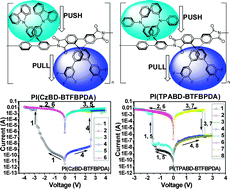Nonvolatile memory devices based on polyimides bearing noncoplanar twisted biphenyl units containing carbazole and triphenylamine side-chain groups†
Abstract
Two novel polyimides, PI(CzBD-BTFBPDA) and PI(TPABD-BTFBPDA), consisting of alternating electron-donating 2,2′-bis[4-(9H-carbazol-9-yl)phenyl]- or 2,2′-bis[4-(diphenylamino)phenyl]-substituted biphenyl moieties and electron-accepting phthalimide moieties were synthesized and characterized. These polyimides are thermally stable with 5% weight loss over 500 °C and the glass transition temperatures of the polyimides were found to be 293 °C. The optical band gaps of PI(CzBD-BTFBPDA) and PI(TPABD-BTFBPDA) were 3.42 and 3.30 eV, respectively, indicating the significance of the linkage groups. The estimated energy levels (HOMO, LUMO) of PI(CzBD-BTFBPDA) and PI(TPABD-BTFBPDA) were (−5.51, −2.10) and (−5.22, −2.02) eV, respectively. Resistive switching devices with the configuration of Al/


 Please wait while we load your content...
Please wait while we load your content...